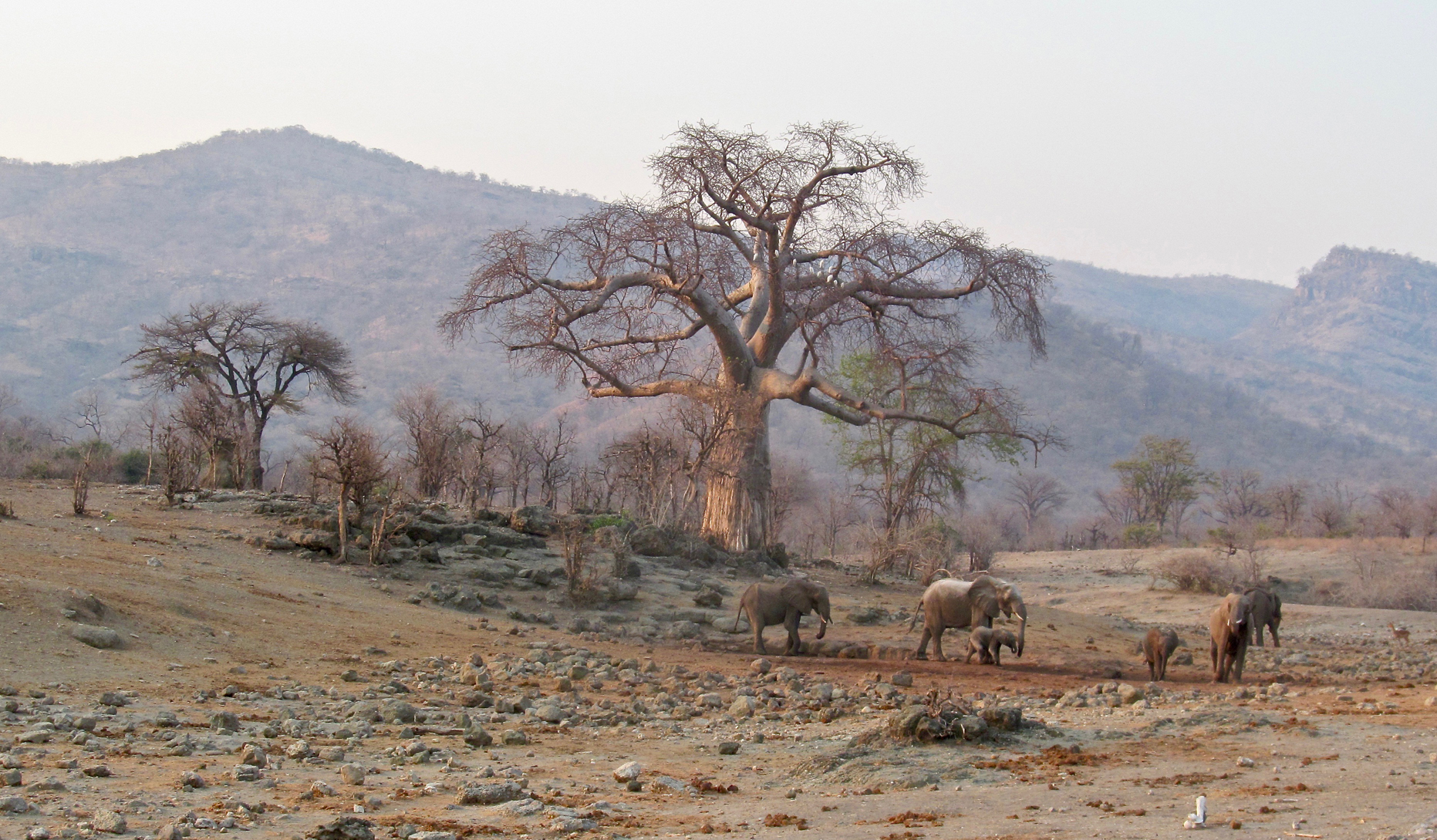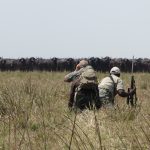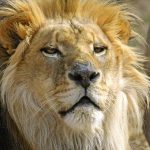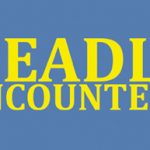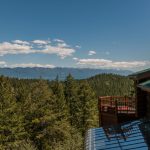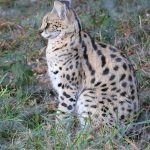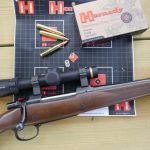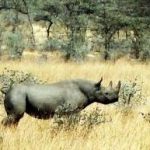A quest for a very old dagga boy in the Zambezi Valley.
“A buffalo hunt has been a lifelong dream of mine,” said seventy-eight-year-old Frank after introducing himself to me at a recent Dallas Safari Club Convention. “I’m told you’re Mr. Buffalo, so can you please help me make it happen?”
What a nice request this was. For the greater part of my professional life, the conservation, management, and sporting pursuit of these formidable black bovines has been my passion.
“I’m of the opinion, Frank, that a buffalo hunt should be more than just a quest for a unique animal,” I told him. “Instead it should be a wilderness experience where the search for a nice, battle-scarred old dagga boy will involve other unique, and therefore special, African experiences. Having to dodge elephant cows and their calves, or bumping into lions while following buffalo tracks, should all be part of the hunt. Also, no buffalo hunt is complete without its nights being disturbed by the grunting of hippos, the giggles of hyenas, the roaring of lions, and the wood-sawing rasps of leopard calls. Many miles of following buffalo spoor should leave you both exhausted and amazed at the skill of African trackers. And you should get the opportunity to track, stalk, and look over numerous bulls before finding the right one. This is what a proper buffalo hunt is all about. The area I have in mind will deliver all this from a tented camp on the banks of the mighty Zambezi River, with its own unique scenery, sounds, and spectacular sunsets. If you’re seriously interested in what I suggest, it’ll be my pleasure to make your dream come true. I know the perfect safari area because I’ve hunted buffalo there many times, and I know well the PH and outfitter who’ll make it all happen. I can assure you, you’ll not be disappointed.”

Frank liked my African wilderness experience suggestion, so I took him to meet Buzz Charlton of Charlton McCallum Safaris, or CMS for short. CMS is, in my opinion, as good as it gets when it comes to such matters, and as I expected, Frank and Buzz hit it off immediately. Frank ended up booking a ten-day buffalo hunt in Zimbabwe’s Nyakasanga Safari Area in the mid-Zambezi Valley for September 2019.
Frank then confessed to a problem: His left knee was in bad shape and in need of replacement, something he was reluctant to have done before the hunt. But if he wore a knee brace and walked slowly, with the aid of a hiking pole, and if the terrain was not too hilly, he reckoned he could, with some prior training, manage the required six to eight miles of daily walking. The other problem was his rifle. Someone would have to carry it for him, because with his wonky knee, he could not. This was when I happily offered my services. In exchange for the opportunity to return to one of my most favorite hunting areas, I would gladly become Frank’s rifle-bearer.
It is often said that the planning and preparations for a buffalo hunt are as enjoyable as the hunt itself. Being at the DSC convention was a bonus because it enabled us to start the process right there and then. In short order, a suitable rifle, a Winchester Model 70 Super Express in .375 H&H, and scope, a 1.5-5X Leupold VX III, were secured. Next on the list was ammunition, so we visited Lonnie Cribb of Superior Ammunition at his booth he was contracted to load 350-grain North Fork SPs for the initial shot, to be followed up with 350-grain Cup-Nosed Solids if backing shots would be needed. Next it was off to African Sporting Creations for a pair of Courtney boots, ankle sock protectors, and leather rifle and binocular slings. My last job was to introduce Frank to Debbie Gracy of Gracy Travel. Debbie would handle Frank’s flights to and from Harare and the paperwork for his rifle. To avoid the hassle of taking a firearm through South Africa, Buzz suggested that Frank fly to Harare via Dubai on Emirates Airlines. This Frank did, and it proved a good decision.
Over the intervening months, Frank and I stayed in regular e-mail contact. His fitness/walking program progressed well, and soon he was walking the required daily distance with ease. September eventually arrived, and I flew to Harare to be there when Frank arrived on the evening Emirates flight. Buzz’s business partner, Myles McCallum, was at the airport to meet us and take us to our overnight accommodation, Amanzi Lodge. After his long journey, Frank was exhausted. We had a couple of Zambezi lagers, a good steak dinner, and went to bed early because Myles wanted a 6:00 a.m. start the next morning.
Our flight from Charles Prince airport to the Sugar Estates airstrip at Chrundu was uneventful. From the air, it was easy to see how desperately dry the Zambezi Valley was. All the inland pans were empty, which meant the wildlife had only two options for their daily water requirements: the Zambezi River itself or a couple of remote springs at the base of the escarpment. Buzz was at the airstrip to meet us, and within an hour we were at the fly camp CMS had set up for us on the banks of the Zambezi, a mile or so upstream from the mouth of the dry Nyakasanga River.
The term “fly camp” is somewhat misleading. Our tents were large and spacious, each with a comfortable bed and ensuite shower, basin, and flush loo. Set under large, shady trees, the camp provided all the creature comforts needed for an extended stay in such a remote location. There was even a fishing boat for evening drifts for tigerfish.
Our drive into camp confirmed Buzz’s initial comment, “We’ll be spoiled for choice because there are buffalo everywhere.” This was evident–the spoor of buffalo herds and small groups of bulls were seen regularly, crossing the dirt track which runs adjacent to the Zambezi. It took only two shots, one with each bullet type, to confirm that Frank’s rifle was dead-on at 100 yards–the ideal sighting-in distance for the relatively close-range shots for which the Zambezi Valley, with its thick bush, is famous.
Around the campfire, Buzz, Frank, and I had some interesting discussions regarding buffalo trophy quality. Having recently spent five years at the Southern African Wildlife College where I had the opportunity to conduct a research project comparing the herd dynamics and trophy quality of two adjacent buffalo populations, one of which was hunted and the other not, my focus these days concentrates on the genetic sustainability of trophy hunting. My research proved conclusively that it is simply not sustainable to continually hunt better-than-average, trophy-quality bulls before they have had the opportunity to breed, or while they are still of breeding age. About this, Frank was suitably convinced, so we set an interesting challenge for his buffalo hunt: to find the oldest, most characterful buffalo in the Nyakasanga.
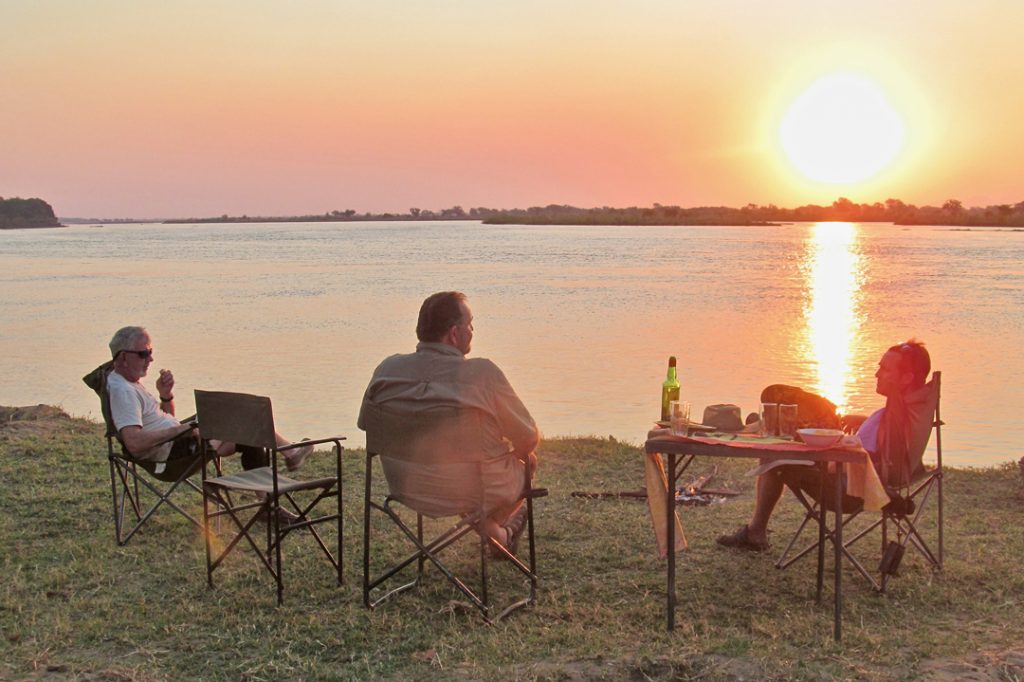
So numerous were the small groups of bulls drinking along the river that for the first time in my extended buffalo hunting career, we were able to follow three or even four such groups a day. This was because Buzz and his two trackers each carried handheld radios and GPS units. Having radio communication with Eddie, our ever-smiling driver, made long walks back to the Land Cruiser after unsuccessful hunts unnecessary. After each hunt, Eddie would collect us at the closest road, and while driving to these collection points he would scout for additional bull tracks. This saved lots of unproductive walking and allowed us to follow many bulls. During the hunt we eventually tracked, stalked, and evaluated more that forty different bulls–a truly wonderful experience.
There are many who believe that because buffalo bulls are on their own or in small groups away from the herds they are post-breeding-age dagga boys. This is not the case. Breeding-age bulls, eight to eleven years of age, leave and rejoin the herds on a regular basis as their body condition and strength fluctuates. Dominant herd bulls have a hard life, constantly having to be on guard duty from both predators or rivals. They graze at the back of the herd on trampled grass or leaves, and don’t spend enough time resting and ruminating, and this causes them to lose weight. When too much body condition is lost, herd bulls leave the breeding herds for some R & R. This is when they regain their strength in preparation for the fights that will ensue for social dominance come the next breeding season.
Bull buffalo get more massive with advancing age. To compensate for this, their front hooves, which carry the majority of their weight, grow bigger. Old bulls also tend to drag their front feet as they amble along, and over time this wears flat the leading edge of their front hooves. Because of this, I believe it possible to age a buffalo bull pretty accurately just from the size and shape of his forefeet tracks.

We were well into the hunt when we found the tracks of the bull we came to call Bigfoot. So large and unique was this bull’s right front foot track that one of the trackers commented, “There is now a giraffe in the Zambezi Valley!” The front edge of Bigfoot’s track was worn flat, and he was a loner. All this indicated an old bull past his prime. We followed his distinctive tracks with enthusiasm, and what a fantastic hunt it turned out to be.
Thanks to a steady breeze blowing from the east and the dry, dusty conditions, we were able to track and then stalk Bigfoot as he slowly limped his way through the jesse, feeding on its fallen leaves. Bigfoot was not putting any weight on his right front leg, and when I eventually got a glimpse of his impressive body size, his blunt-tipped horns, and well-developed chinlap, I realized he was indeed something special. He was also almost completely bald. Bigfoot was a very old bull and I initially aged him to be at least in his thirteenth year. He was just the type of bull Frank was looking for, and as a bonus, he was totally unaware of our presence.
Buzz guided Frank in close and got him set up on the shooting sticks. They then patiently waited for Bigfoot to offer a shooting opportunity. It is customary for buffalo to graze into and across the prevailing wind in a meandering, zigzag fashion. They do this so moving air currents will alert them to the presence of lions up ahead. This is exactly what Bigfoot did. He eventually zigged to the left, exposing his shoulder as he did so. This was the moment Frank had been waiting for, and his shot was well placed. The heavy-for-caliber North Fork did its job perfectly.
Hard-hit, Bigfoot only managed to hobble a few paces before turning to expose his right shoulder. At this, Frank fired a backup shot and Bigfoot simply dropped to the ground, all of which was caught on camera by the hunt’s cameraman, Justin Drainer.
That Bigfoot was old was obvious. My initial estimation of him being at least thirteen was conservative. When I eventually got to measure his lower jaws and two first molar teeth, and then age him with the Taylor method, he turned out to be well into his fourteenth year. In the Zambezi Valley and similar areas where predators occur, very few buffalo make it past fifteen years of age, so Bigfoot was close to the end of his natural life. What a bull he must have been to have survived for so long with a broken metacarpal bone, the reason for his limp and his exceptionally large front hoof–testimony to the toughness and tenacity of these incredible bovines. Frank sure was successful in his quest for the Nykasanga’s oldest and most characterful bull; Bigfoot ticked all the boxes, and then some.


